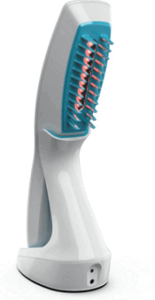
Until several years ago, I used to be a skeptic when it comes to low-level laser therapy (LLLT) for hair loss. This is not to say that I felt there was zero logic in using lasers to treat scalp hair loss.
In fact, for years, I have heard of laser body hair removal causing the unwanted and opposite side effect of laser body hair growth stimulation in some people. A phenomenon termed as paradoxical hypertrichosis, which affects 3 percent of hair removal patients per a recent study.
However, I felt that the benefits of LLLT aka photobiomodulation (PBM) on scalp hair are modest at best. Lasers used for body hair removal at clinics are far more powerful and different from those used to treat scalp hair loss. Even less powerful at-home laser hair removal devices are often stronger than those used to treat scalp hair loss.
Updated: April 13, 2022
New Studies on LLLT for Hair Loss
Since I first wrote this post, a number of new studies in support of low-level laser light therapy for hair growth have been published.
- An April 2022 study from China finds that low-level laser treatment promotes skin wound healing in mice by activating hair follicle stem cells. I always think of LLLT and wounding as somewhat overlapping in concept.
- A December 2021 study from China found hair growth promoting effects from 650 nm red light stimulation.
- September 2021 findings from Dr. Gentile of Italy: “All the articles selected and analyzed reported a positive effect of LLLT for MPHL and/or FPHL treatment without side effects”.
- A May 2021 study concluded that low-level light therapy downregulates scalp inflammatory biomarkers in men with androgenetic alopecia. Moreover, LLLT also boosts the effectiveness of Minoxidil on hair growth. Note that this research was conducted in France by the reputable L’Oréal.
- Also from May 2021, yet more findings that photobiomodulation therapy activates β-Catenin in hair follicle stem cells.
- A 2020 literature review of ten controlled clinical trials concludes that LLLT appears to be safe and effective for treating pattern hair loss in both men and women. However, the authors caution that some studies “have a relationship with the industry”.
- According to this summary, as of September 2020 there were 66 LLLT devices registered with the US FDA.
- A 2019 study from Thailand conducted proteomic analysis of dermal papilla cells before and after treatment with low-level laser therapy. The analysis revealed 11 up-regulated and 2 down-regulated proteins in LLLT treated DP cells compared with baseline.
Also of note, at the recent 2022 AAD conference, there was a session on Photobiomodulation (PBM) therapy and hair growth. One of the items of discussion pertained to the use of LLLT in combination with PRP.
Low-Level Laser Therapy Wavelengths
The lasers that are used in LLLT typically have a wavelength of anywhere between 600 to 900 nanometers (nm). Anything below 600 nm tends to work less effectively. However, one study found lower wavelength blue light (453 nm) to be more effective.
The bestselling laser hair growth devices all use wavelengths of red or near-infrared light (i.e., around 650 nm). Of note, a study from South Korea found that a higher wavelength of 830 nm gave the best results (albeit in mice). For more on this subject, see my posts on low level laser therapy for hair loss wavelengths. Also check out my post on the use of higher wavelength fractional lasers for stimulating hair growth.
LLLT Debate
This old debate from 2008 between Dr. Feller and Dr. Bauman is quite interesting. Dr. Bauman was also part of a now famous 2004/2005 Dateline NBC show that followed 5 patients on different treatment protocols. The HairMax Lasercomb resulted in the most favorable (but not stellar) hair regrowth results. See patient “George” and his before and after photos at 8:10 onwards in this video:
Laser Devices for Hair Growth
Nowadays, numerous physicians support the use of FDA cleared at-home low-level laser devices for hair growth. The Amazon.com customer reviews for LLLT products typically average around 4.0 out of 5.0 stars.
However, I would advise always looking at reviews with a critical eye. Only give credence to reviewers who have their names verified. Make sure to focus on those who have posted reviews of many different types of products over several years.

